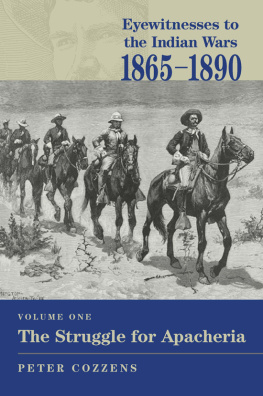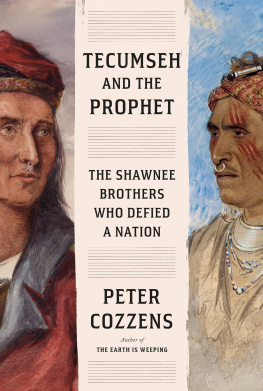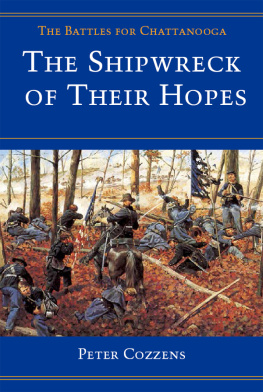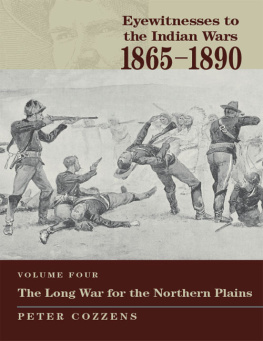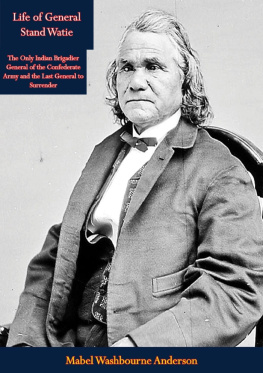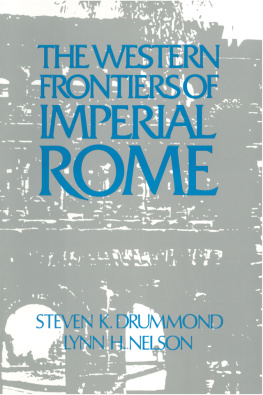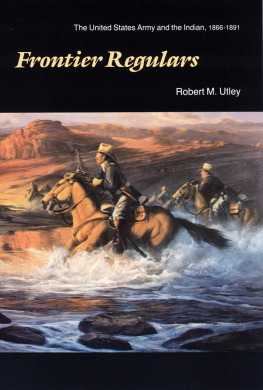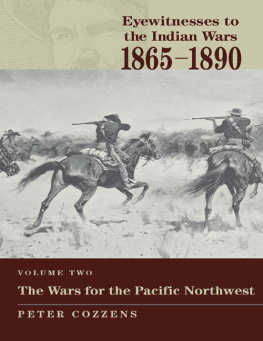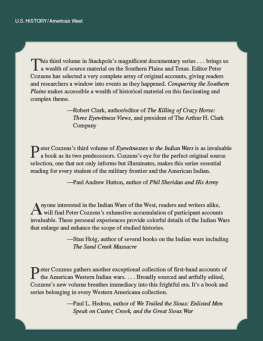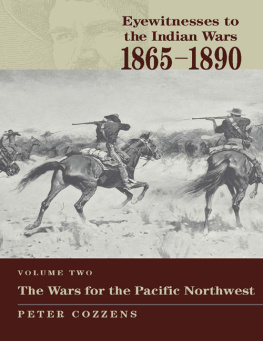EYE WITNESSES TO THE INDIAN WARS,
18651890
ALSO BY PETER COZZENS
No Better Place to Die: The Battle of Stones River
This Terrible Sound: The Battle of Chickamauga
The Shipwreck of Their Hopes: The Battles for Chattanooga
The Darkest Days of the War: The Battles of Iuka and Corinth
The Military Memoirs of General John Pope
General John Pope: A Life for the Nation
Battles and Leaders of the Civil War, Vol. 5
The New Annals of the Civil War (with Robert I. Girardi)
Eyewitnesses to the Indian Wars, 18651890: Vol. 1, The Struggle for Apacheria
Eyewitnesses to the Indian Wars, 18651890: Vol. 2, The Wars for the Pacific Northwest
Eyewitnesses to the Indian Wars, 18651890: Vol. 3, Conquering the Southern Plains
Eyewitnesses to the Indian Wars, 18651890: Vol. 4, The Long War for the Northern Plains
EYEWITNESSES TO THE INDIAN WARS, 18651890
The Army and the Indian
EDITED BY PETER COZZENS
STACKPOLE
BOOKS
For Issa, whom I feel blessed to call my wife
Copyright 2005 by Stackpole Books
Published by
STACKPOLE BOOKS
5067 Ritter Road
Mechanicsburg, PA 17055
www.stackpolebooks.com
All rights reserved, including the right to reproduce this book or portions thereof in any form or by any means, electronic or mechanical, including photocopying, recording, or by any information storage and retrieval system, without permission in writing from the publisher. All inquiries should be addressed to Stackpole Books, 5067 Ritter Road, Mechanicsburg, Pennsylvania 17055.
Printed in the United States of America
10 9 8 7 6 5 4 3 2 1
FIRST EDITION
Library of Congress Cataloging-in-Publication Data
Eyewitnesses to the Indian Wars, 1865-1890 / edited by Peter Cozzens.1st ed.
p. cm.
Includes index.
Contents: v. 5. The Army and the Indian
ISBN: 0-8117-0123-9
I. Cozzens, Peter, 1957
E99.A6 E94 2002
973.8dc21
00-52270
eBook ISBN: 978-0-8117-4953-4
LIST OF ILLUSTRATIONS
PREFACE
Eyewitnesses to the Indian Wars, 18651890: The Army and the Indian is the fifth and final volume of a five-volume series that tells the saga of the military struggle for the American West in the words of the soldiers, noncombatants, and Native Americans who shaped it.
Each of the first four volumes of the series is dedicated to a particular region of the American West and the conflicts that characterized its settlement. Volume Five includes accounts that transcend a single region or conflict, as well as a handful of accounts that I discovered after publication of the volume that dealt with their region. Subjects include sketches of key military figures and their campaigns; narratives of army wives, junior officers, and enlisted men; accounts of garrison life; writings and speeches of army officers on Indian policy; narratives of army scouts; and discussions of Indian-fighting doctrine and tactics.
In the present volume, I have sought to offer as representative a selection of original accounts pertaining to the postCivil War frontier army and its relationship with the Native American residents of the West as may be assembled under one cover. As these accounts show, the relationship between soldier and Native American was far more complex than that of simple antagonists. Much sympathy existed among the militaryparticularly the high commandfor the plight of the American Indian, as evidenced in the thoughtful articles on the Indian Question. That the army struggled both morally and practically with its role as a frontier police force becomes clear from both the Indian Question essays and the articles on the frontier army that precede them. The accounts in the sections Officers and Enlisted Men and The Army and the Indian reveal the human side of the conundrum. Young officers and soldiers thrown into daily contact with the Indians often found them far superior companions to the frontiersmen they were expected to protect. Many in the army wanted to open its ranks to Indians, as articles in the section Army Scouts and Indian Auxiliaries demonstrate. With the officers and enlisted men came their wives. The section Women on the Military Frontier presents their perspective on the military frontier.
As in earlier volumes, most of the accounts presented here are taken from contemporaneous newspapers and magazines or from unpublished manuscripts. Several considerations have guided my choice of material for inclusion in the series. The events described must have occurred between the end of the Civil War and the tragedy at Wounded Knee. With but few exceptions, the articles were published during the authors lifetimes. Articles published within the last fifty years have been excluded, as they are for the most part readily available.
My goal in editing the selections in this volume has been to present accurate and annotated texts. I have added notes to correct errors of fact, clarify obscure references, provide historical context where needed, offer capsule biographies of contributors, and identify more fully persons mentioned in the text.
Editing of the text has been light. Many nineteenth-century writers had a penchant for commas, for commas and hyphens in combination, and for semicolons. I have eliminated them where their overuse clouds the meaning or impedes the rhythm of a sentence. I have regularized capitalization, punctuation, and the spelling of names and places. I have replaced references to officers brevet, or Civil War volunteer, ranks with their actual rank at the time of the events described. Thus Bvt. Maj. Gen. George A. Custer becomes Lt. Col. George A. Custer, Bvt. Maj. Gen. John Gibbon becomes Col. John Gibbon, and so forth. Lieutenant colonels are referred to as colonel when only their last name is mentioned in the text, thus Colonel Custer; this courtesy follows normal military usage.
PART ONE
The Frontier Army, 186590
We Do Our Duty According to Our Means
WILLIAM T. SHERMAN
Army and Navy Journal 6, no. 7 (September 26, 1868): 85
T he Cheyenne Star publishes the following letter from Lieutenant General Sherman:
ST. LOUIS, September 6, 1868
Hon. O. T. B. Williams, Cheyenne, Wyoming:
DEAR SIR: In my hurried departure from Fort Sanders,concurred with it in some respects, but differed in others, and yet, by an executive order, was required to conform my military action to its decisions. There were some members to that commission from civilians, and then army officers. We naturally regarded the questions which arose from our respective standpoints, but in our conclusions were generally of one opinion.
From the very origin of our government, the Indians have been held to possess a certain title to the lands held by them, for the surrender of which the general government has always treated and made compensation. We found the Cheyennes, Arapahos, Kiowas, and Sioux in possession of the Plains traversed by our great highways, and we proceeded to treat with them all in detail and made with them treaties by which they agreed to surrender to us substantially the base region now embraced in Nebraska, Kansas, Colorado, and Wyoming, and to remove and permanently occupy reservations north and south, described in my General Orders No. 4. To accomplish their removal, Congress has placed in my hands certain moneys, which I shall disburse for that sole purpose, and when Indians have failed to act in good faith, they shall receive nothing from me.
All Indians are lawfully under the control of the Interior Department, by and through civilian agents; but that department is extremely jealous of any interference by the military, so that our officers and soldiers have no right to anticipate Indian hostilities, but can only act against Indians after the commission of hostile acts. In all the treaties by the Indian peace commissions was a clause of doubtful wisdom, viz: leaving the Plains Indians the right to hunt buffalo as long as they lasted, outside of their reservations. Without this condition, it was contended, no peace could be concluded, and though the members varied in opinions, this concession was made by a decided majority and tried on, as long as the Indians maintain peace. But as they have broken the peace, I have ordered the military to renew their efforts to remove to their proper reservations all Indians who have not been drawn into war, and to kill, destroy, and capture all who have been concerned in the recent acts of hostility. Nearly all the people on the Plains, even the governors of the states and territories, who ought to know better, seem to have an idea that I have a right to make war and peace at pleasure; a right to call out volunteers and pay them, and to do more in this connection than any monarch of a constitutional kingdom. I possess none of these powers. The Regular army is provided by Congress, and but a small portion of it is assigned to my command. With this small force I am required to protect two railroads, the Missouri River, the various stage routes, amounting in the aggregate to over eight thousand miles of traveled road, besides the incidental protection of tens of thousands of miles of frontier settlements. Each of these settlements exaggerates its own importance and appeals for help, from Minnesota to Arkansas, and from Montana to New Mexico. Were I to grant ten men where a hundred are called for, our little army would be so scattered as to be of little or no use. With this small force, in the last two years, I have done as much as any reasonable man could hope for, and if any man be incredulous, let him enlist in any company, and he will soon find out if he don't earn his pay.


